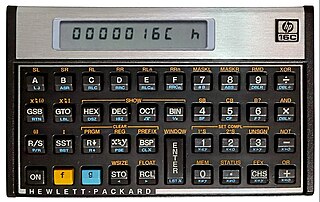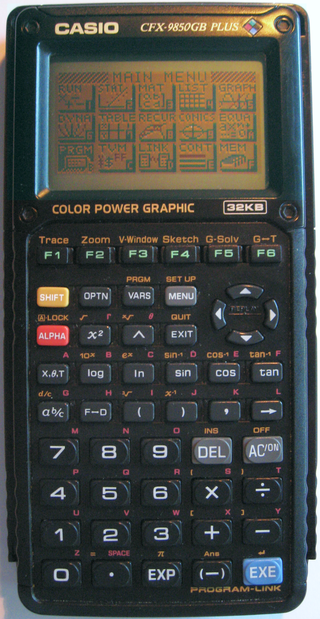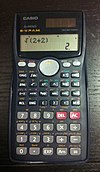
The Commodore PET is a line of personal computers produced starting in 1977 by Commodore International. A single all-in-one case combines a MOS Technology 6502 microprocessor, Commodore BASIC in read-only memory, keyboard, monochrome monitor, and, in early models, a cassette deck.

In computing, PEEK and POKE are commands used in some high-level programming languages for accessing the contents of a specific memory cell referenced by its memory address. PEEK gets the byte located at the specified memory address. POKE sets the memory byte at the specified address. These commands originated with machine code monitors such as the DECsystem-10 monitor; these commands are particularly associated with the BASIC programming language, though some other languages such as Pascal and COMAL also have these commands. These commands are comparable in their roles to pointers in the C language and some other programming languages.

A graphing calculator is a handheld computer that is capable of plotting graphs, solving simultaneous equations, and performing other tasks with variables. Most popular graphing calculators are programmable calculators, allowing the user to create customized programs, typically for scientific, engineering or education applications. They have large screens that display several lines of text and calculations.

The TI-85 is a graphing calculator made by Texas Instruments based on the Zilog Z80 microprocessor. Designed in 1992 as TI's second graphing calculator, it was replaced by the TI-86, which has also been discontinued.

The HP 33s (F2216A) was a scientific calculator marketed by Hewlett-Packard. It was introduced in 2003 as the successor to the HP 32SII, and discontinued on the introduction of its successor the HP 35s in 2007.

The Tandy Pocket Computer or TRS-80 Pocket Computer is one of a line of 1980s small pocket computers—calculator-sized programmable computing devices—sold by Tandy Corporation under the "Tandy" or "RadioShack TRS-80" brands.
MBASIC is the Microsoft BASIC implementation of BASIC for the CP/M operating system. MBASIC is a descendant of the original Altair BASIC interpreters that were among Microsoft's first products. MBASIC was one of the two versions of BASIC bundled with the Osborne 1 computer. The name "MBASIC" is derived from the disk file name MBASIC.COM of the BASIC interpreter.

The Casio FX-7000G is a calculator which is widely known as being the world's first graphing calculator available to the public. It was introduced to the public and later manufactured between 1985 and c. 1988. Notable features are its ability to graph functions, and that it is programmable. The calculator offers 82 scientific functions and is capable of manual computation for basic arithmetic problems.
Programmable calculators are calculators that can automatically carry out a sequence of operations under control of a stored program. Most are Turing complete, and, as such, are theoretically general-purpose computers. However, their user interfaces and programming environments are specifically tailored to make performing small-scale numerical computations convenient, rather than general-purpose use.
Galaksija BASIC was the BASIC interpreter of the Galaksija build-it-yourself home computer from Yugoslavia. While being partially based on code taken from TRS-80 Level 1 BASIC, which the creator believed to have been a Microsoft BASIC, the extensive modifications of Galaksija BASIC—such as to include rudimentary array support, video generation code and generally improvements to the programming language—is said to have left not much more than flow-control and floating point code remaining from the original.

The HP-16C Computer Scientist is a programmable pocket calculator that was produced by Hewlett-Packard between 1982 and 1989. It was specifically designed for use by computer programmers, to assist in debugging. It is a member of the HP Voyager series of programmable calculators. It was the only programmer's calculator ever produced by HP, though many later HP calculators have incorporated most of the 16C's functions.

The Casio CFX-9850G series is a series of graphing calculators manufactured by Casio Computer Co., Ltd. from 1996 to 2008.
The Casio fx-9860G is a series of graphing calculators manufactured by Casio, successor of the fx-9750G PLUS/CFX-9850 PLUS/CFX-9950 PLUS/CFX-9970 family of calculators. All of them are capable of being programmed by means of sophisticated languages and tools including assembly language, Basic variants, and ports of programming languages such as C, as well as hosting add-ins which are compiled on a computer and then downloaded to the calculator.

Casio fx-3650P is a programmable scientific calculator manufactured by Casio Computer Co., Ltd. It can store 12 digits for the mantissa and 2 digits for the exponent together with the expression each time when the "EXE" button is pressed. Also, the calculator can use the previous result to do calculations by pressing "Ans". It is one of the calculators approved by HKEAA to be used in public examinations in Hong Kong, such as HKDSE.

The TRS-80 Model II is a computer system launched by Tandy in October 1979, and targeted at the small-business market. It is not an upgrade of the original TRS-80 Model I, but a new system.

The FX-603P was a programmable calculator, manufactured by Casio from 1990. It was the successor model to the Casio FX-602P. Since it was only released in a limited number of countries in small quantities, it is now an excessively rare item which commands high prices when sold.

The FX-601P and FX-602P were programmable calculators, manufactured by Casio from 1981. It was the successor model to the Casio FX-502P series and was itself succeeded in 1990 by the Casio FX-603P.

The FX-501P and FX-502P were programmable calculators, manufactured by Casio from 1978/1979. They were the predecessors of the FX-601P and FX-602P.

The FX-702P is a Pocket Computer, manufactured by Casio from 1981 to 1984.

The Casio Algebra FX series was a line of graphing calculators manufactured by Casio Computer Co., Ltd from 1999 to 2003. They were the successor models to the CFX-9970G, the first Casio calculator with computer algebra system, or CAS, a program for symbolic manipulation of mathematical expressions. The calculators were discontinued and succeeded by the Casio ClassPad 300 in 2003.

















